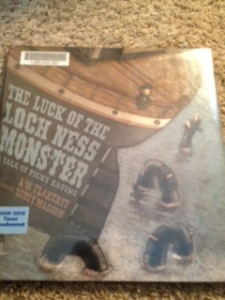
I’ve been thinking a lot about teaching writing for younger students and how I can make less enthusiastic writers more engaged in the writing process. A big part of me has been so used to working with motivated upper elementary students that I forget how younger writers need time for processing and creating before they can even put pencil to paper.

I came up with this lesson idea for students to create their own creature after reading the fabulous poetry book, “Scranimals” by Jack Pretlutsky. This text is so rich and inspiring for children and adults. It pairs witty rhyming poetry with quirky illustrations of Peter Sis as it describes the behaviors of Scranimals, an imaginary creature made up of an animal and food. Some of the Scranimals my students loved reading about included the Potatoad, a potato and a toad who is lazy and doesn’t want to eat, drink or even think and the Radishark , a shark and radish who wants to consume everything in its sight. It certainly helps that Jack Pretlutsky’s witty lines cause even the most reluctant poetry reader to giggle at that thought of a radishark trying to eat your behind.

I tested this lesson out with Ms. Howland’s 2nd grade classroom. They are such talented writers and are so eager to try new types of writing with me. I really wanted the students to feel like their creatures would come to life and I wanted to allow them to create 3D models of their creatures. Cheap playdough at the dollar store (8 containers for $1!) was the answer to my prayers. For less than $5 I had enough playdough for each child to get their own container and they were instantly hooked on my lesson.

I didn’t want the purpose of the lesson to just be making creatures out of playdough. I wanted to really pull in a teaching point to illustrate a specific writing strategy. I wanted to teach students that writers create characters (human, animal, or imaginary) that have traits we see in ourselves and other people. I wanted students to be able to connect to this lesson for their future writing projects and make text-to-text connections as they read favorite books. As we read each poem about a Scranimal, I asked students to share what they thought this creature liked to do, eat, disliked doing, and even their hidden talents. I really tried to push students to infer and think beyond the text to consider what this creature might be like in real life.

Working with younger students has taught me that creating structures is really important. I made a “Character Profile” sheet to assist students as they planned out their character. I wanted to give them a tool to help them when they begin writing their own stories and poetry about their creature. I took time to brainstorm possible animal combinations with the students before modeling the character profile sheet. This really helped the students envision what their own character profile sheet would be like therefore easing the process for them to work independently. It also helped having a planning sheet that needed to be completed before they could begin sculpting with their dough.
The students took off writing down ideas and creating their own creatures. They were SO creative and excited about making their own animals. Being able to use words, sketched pictures, and create a 3D model really helped make these creatures come to life. Rarely do I love hearing a noisy and loud writer’s workshop but there is nothing better than hearing excited whispers from students on what they are working on. Students were completely motivated to make a creature that they loved and wanted to make just so. It really made me think back to the Katie Wood Ray presentation I heard in the fall when she said, “Students must have a vision to do their work”. I couldn’t agree more. In this lesson students had total control, choice, and vision for their work. Students who were struggling to have vision were able to use examples from the book and their peers to become inspired. Following this lesson, students will take their creations and profile sheet to write their own poetry and stories about their creatures.
